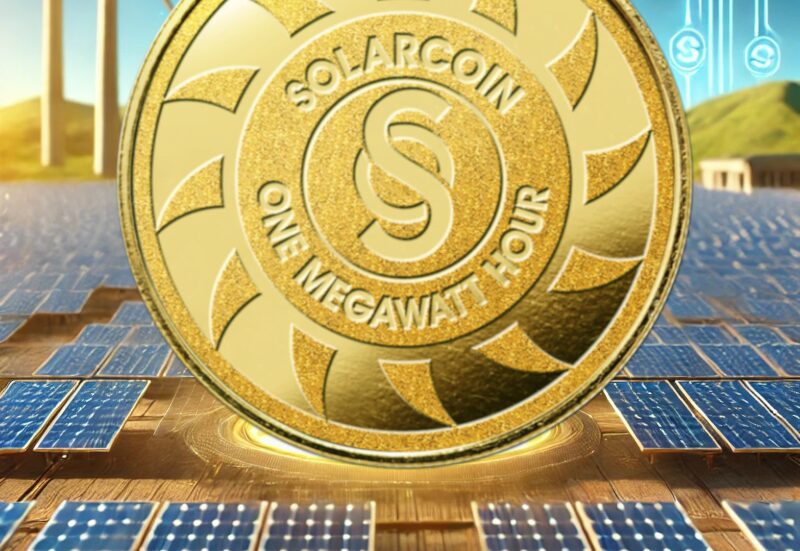There is a cryptocurrency that does not just exist in the digital ether, floating around on speculative markets and pumping on Twitter hype.
SolarCoin is different. It is tied to something real, solar energy. Every time a solar panel generates electricity, SolarCoin offers a financial incentive for renewable energy adoption.
While the concept sounds like a futuristic dream, it has been operating for over a decade, with billions of coins still waiting to be claimed.
Make Money from the Sun
SolarCoin launched in 2014 as a decentralized, global rewards program designed to accelerate solar energy adoption. Unlike Bitcoin, which is mined through energy-intensive computing processes, SolarCoin is earned by proving solar energy production.
For every megawatt-hour of verified solar electricity generated, the producer receives one SolarCoin. Whether it is a homeowner with rooftop panels or a massive solar farm, anyone producing solar power can register and claim these tokens.
Verification happens through a simple process. Producers submit documentation proving their solar energy generation.
Some can even automate verification through approved monitoring services, streamlining the rewards. Once verified, SolarCoins are deposited into a digital wallet, where they can be held, traded, or used in various applications.
The Green Crypto Jackpot
The goal behind SolarCoin is simple. It creates an additional financial incentive for people to install and operate solar energy systems. Selling solar power back to the grid is one way to monetize renewables, but SolarCoin adds another layer.
It is an independent, global reward that exists beyond government subsidies or local incentives.
With a supply cap of 98.34 billion coins, SolarCoin is designed to reward up to 97,500 terawatt-hours of solar power generation over its 40-year distribution period. The idea is to provide a long-term incentive that encourages both individuals and businesses to choose greener energy options.
The Tech Making It All Work
Unlike early versions of the project that relied on Proof-of-Work mining, the same model used by Bitcoin, SolarCoin transitioned to a Proof-of-Stake-Time consensus mechanism. This means it no longer requires energy-intensive mining, making it far more sustainable.
It operates on its own blockchain but is also compatible with Ethereum as an ERC-20 token. This allows it to interact with decentralized finance applications.
As blockchain technology evolves, this flexibility increases the chances of SolarCoin integrating with the broader cryptocurrency economy while staying true to its green energy mission.
Is This the Next Crypto Goldmine?
SolarCoin is traded on several cryptocurrency exchanges, allowing users to convert it into Bitcoin, Ethereum, or fiat currency. However, its market value has fluctuated, and it has not yet reached mainstream adoption.
Some energy companies and businesses are beginning to recognize SolarCoin as a valid incentive for clean energy initiatives.
The real value proposition lies in its potential. If large-scale solar producers start adopting it in higher volumes, demand could rise, boosting the coin’s financial worth. Additionally, if governments or corporations see its potential as a tool to track and incentivize renewable energy, it could become a key player in the green finance sector.
The concept of a solar-backed cryptocurrency has not gone unnoticed. SolarCoin has been recognized by organizations like the United Nations Development Programme and the International Renewable Energy Agency as a private sector initiative supporting clean energy.
Several European and American solar energy producers have experimented with the program. Over 12 terawatt-hours of verified solar energy production across 71 countries have already been rewarded with SolarCoins. Some solar firms even offer SolarCoin as an additional incentive to customers who install panels through their services.
What’s Holding SolarCoin Back?
Despite its innovative model, SolarCoin faces several challenges. Awareness remains low compared to mainstream cryptocurrencies. Adoption is slow, with many solar producers either unaware of the program or uninterested in participating. The lack of liquidity and limited merchant adoption also means that while SolarCoin has value, spending it is not yet practical in most cases.
However, there are signs of progress. The rise of tokenized assets and blockchain-based carbon credits is putting renewable energy projects in the spotlight.
If SolarCoin can integrate into carbon trading markets or decentralized finance energy platforms, its utility could increase dramatically. As the world transitions toward cleaner energy and seeks new incentives to push solar adoption, SolarCoin could find itself positioned for a second wave of growth.
SolarCoin is an ambitious, forward-thinking attempt to merge cryptocurrency with renewable energy incentives. It provides a way to financially reward solar energy production outside of traditional subsidies and feed-in tariffs.
While it has not yet reached mainstream adoption, its existence highlights a growing trend, using blockchain technology to track and incentivize sustainable actions.
As the world races toward a cleaner energy future, the concept behind SolarCoin remains as relevant as ever. Whether it eventually becomes a widely used green currency or simply serves as an early experiment in blockchain-powered energy rewards, it stands as an example of how cryptocurrency can be used for more than just speculation.




